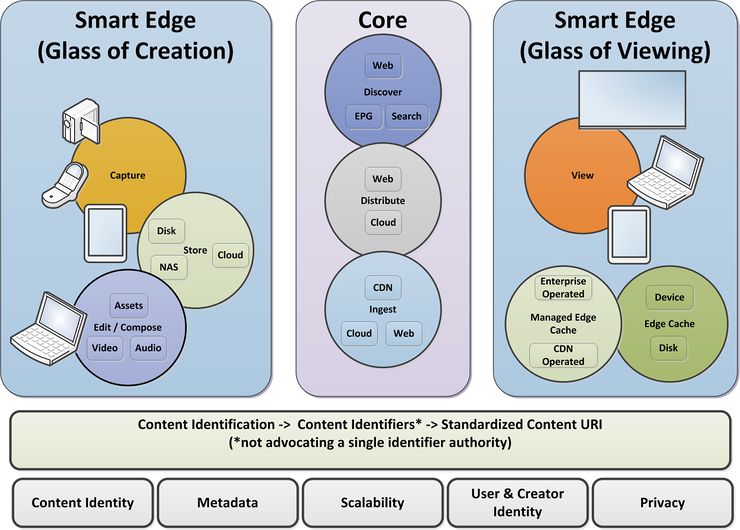GGIE TF/UseCases
This page is dedicated for the discussion on new use cases and topics for discussion in the GGIE TF.
GGIE Taskforce Use Cases
Abstract
This document describes use cases for the glass to glass digital video ecosystem ranging from capture through to viewing.
Status of this document
This is a public working in draft collection of use cases that the GGIE Task Force is discussing and exploring. It has no official standing of any kind and does not represent the support or consensus of any standards organization or contributor. This is a subset of the W3C Public Web & TV Interest Group - Glass to Glass Internet Ecosystem Task Force.
Conventions
The key words "MUST", "MUST NOT", "REQUIRED", "SHALL", "SHALL NOT", "SHOULD", "SHOULD NOT", "RECOMMENDED", "MAY", and "OPTIONAL" in this document are to be interpreted as described in RFC 2119 [RFC2119].
Common Requirements
- As the GGIE TF proceeds this section will be used to capture common requirements that have reached rough consensus within the group
- Network
- The network is assumed to IPv6 meaning that use cases may cite IPv6 only features
- Identified content URI
- A standardized URI to refer to a work of content
- Example uri://eidr:10.5240:7791-8534-2C23-9030-8610-5/[other fields yet to be discussed]
- There will exist a standardized URI referring to identified content.
- The URI will contain a content identifier section with a namespace or domain identifier for the system which issued the content identifier, and a content identifier. e.g. eidr:10.5240:7791-8534-2C23-9030-8610-5
Terminology
- Asset Identifier
- See Content Identifier
- Ad-ID
- A content identifier widely used in the advertising industry to identify advertising assets Ad-ID
- CDN or Content Distribution Network
- A service which provides storage and delivery of digital assets typically using servers located near the edge of the network close to viewers of the content.
- Content Identifier
- A unique identifier used to label a digital content asset. Examples are the EIDR Identifier, Ad-ID
- EIDR Identifier aka EIDR
- A unique identifier for movie and television assists issued by the Entertained Identity Registry. EIDR Technical Documentation
- Fingerprint
- A comparative identifier produced by processing one or more elements, such as audio or video, of an item of digital content such as video trough an algorithm that intent of produce a distinct and deterministic reproducable identifier associated with the content. Typically fingerprints types are: 1) Audio fingerprints derived by on processing the audio portion of digital content; 2) Video fingerprints derived by processing the video portion of digital content. Fingerprints may represent anything from a small number of frames or seconds of a large work, to an entire work.
- Watermark
- Data inserted into a digital content asset which can later be detected and extracted. Common types of watermarks are: 1) Audio where data is inserted into the audio signal; 2) Video where data is inserted into the video picture. Watermarks are typically designed to not be noticeable by listeners or viewers so as not to interfere with the digital content presentation. However, this is not a rule, as visible watermarks are often used to insert identifiers representing the distributor or producer of the content. Watermarks may be robust, meaning they are designed so as to survive transcodings such as to different codecs or resolutions or intentional removal attempts. Some watermarks permit erasure, or removal.
Use Cases
Identity Use Cases
User Content Discovery/Search/EPG/Media Library
Viewing Use Cases
Content Identification & Measurement Use Cases
Network Location and Access Use Cases
Content Capture Use Cases (Cameras)
Templates
Template for Use Cases
- This is a generic template for proposing use cases that should be discussed by the IG TFs. Note that TFs may extend the template if/as needed, so check with your TF moderator if you are not sure.
- !- See the comments in the source for this page to get a cut-page template -!
- UC-
- use case ID and title
- Extends
- use case IDs of the other use cases this extends/builds on
- Description
- high level description/overview of the goals of the use case.
- Schematic Illustration (devices involved, work flows, etc) (Optional)
- Implementation Examples (Optional)
- Actors
- declare any new distinct actors/services/devices that need to be defined
- Dependencies
- other use cases, proposals or other ongoing standardization activities which this use case is dependant on or related to'
- Gaps
- Gaps in available standards or technology that this use case identifies or is dependent upon
- Notes
- any relevant comment that is good to track related to this use case
- Author(s)
- list author/contributor names and email addresses. Add additional contributors over time
- HIstory
- date+editor+short description of what was changed.
- example: 3-12-2015 Glenn Deen added history section to use case template
Normative References
[RFC 2119] Bradner, S., "Key words for use in RFCs to Indicate Requirement Levels", BCP 14, RFC 2119, March 1997.
[RFC 7302] P. Lemieux, "Entertainment Identifier Registry (EIDR) URN Namespace Definition"
Home Network TF Requirements Requirements from the Web & TV IG task force on Home Network Requirements
